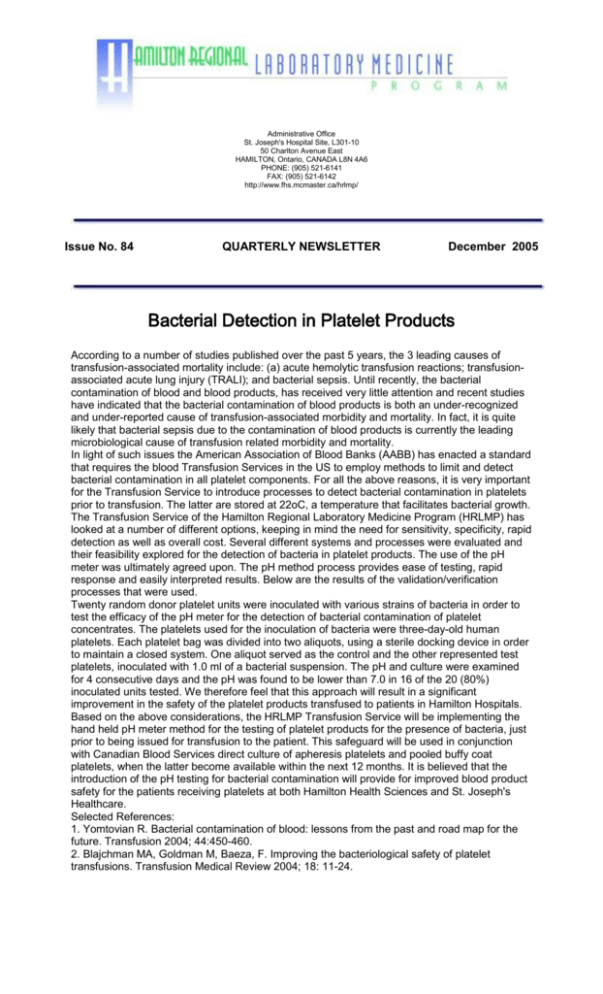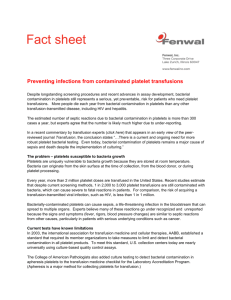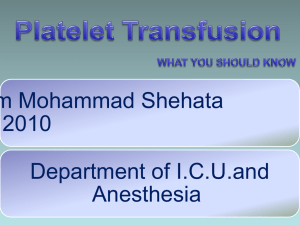Bacterial Detection in Platelet Products
advertisement

Administrative Office St. Joseph's Hospital Site, L301-10 50 Charlton Avenue East HAMILTON, Ontario, CANADA L8N 4A6 PHONE: (905) 521-6141 FAX: (905) 521-6142 http://www.fhs.mcmaster.ca/hrlmp/ Issue No. 84 QUARTERLY NEWSLETTER December 2005 Bacterial Detection in Platelet Products According to a number of studies published over the past 5 years, the 3 leading causes of transfusion-associated mortality include: (a) acute hemolytic transfusion reactions; transfusionassociated acute lung injury (TRALI); and bacterial sepsis. Until recently, the bacterial contamination of blood and blood products, has received very little attention and recent studies have indicated that the bacterial contamination of blood products is both an under-recognized and under-reported cause of transfusion-associated morbidity and mortality. In fact, it is quite likely that bacterial sepsis due to the contamination of blood products is currently the leading microbiological cause of transfusion related morbidity and mortality. In light of such issues the American Association of Blood Banks (AABB) has enacted a standard that requires the blood Transfusion Services in the US to employ methods to limit and detect bacterial contamination in all platelet components. For all the above reasons, it is very important for the Transfusion Service to introduce processes to detect bacterial contamination in platelets prior to transfusion. The latter are stored at 22oC, a temperature that facilitates bacterial growth. The Transfusion Service of the Hamilton Regional Laboratory Medicine Program (HRLMP) has looked at a number of different options, keeping in mind the need for sensitivity, specificity, rapid detection as well as overall cost. Several different systems and processes were evaluated and their feasibility explored for the detection of bacteria in platelet products. The use of the pH meter was ultimately agreed upon. The pH method process provides ease of testing, rapid response and easily interpreted results. Below are the results of the validation/verification processes that were used. Twenty random donor platelet units were inoculated with various strains of bacteria in order to test the efficacy of the pH meter for the detection of bacterial contamination of platelet concentrates. The platelets used for the inoculation of bacteria were three-day-old human platelets. Each platelet bag was divided into two aliquots, using a sterile docking device in order to maintain a closed system. One aliquot served as the control and the other represented test platelets, inoculated with 1.0 ml of a bacterial suspension. The pH and culture were examined for 4 consecutive days and the pH was found to be lower than 7.0 in 16 of the 20 (80%) inoculated units tested. We therefore feel that this approach will result in a significant improvement in the safety of the platelet products transfused to patients in Hamilton Hospitals. Based on the above considerations, the HRLMP Transfusion Service will be implementing the hand held pH meter method for the testing of platelet products for the presence of bacteria, just prior to being issued for transfusion to the patient. This safeguard will be used in conjunction with Canadian Blood Services direct culture of apheresis platelets and pooled buffy coat platelets, when the latter become available within the next 12 months. It is believed that the introduction of the pH testing for bacterial contamination will provide for improved blood product safety for the patients receiving platelets at both Hamilton Health Sciences and St. Joseph's Healthcare. Selected References: 1. Yomtovian R. Bacterial contamination of blood: lessons from the past and road map for the future. Transfusion 2004; 44:450-460. 2. Blajchman MA, Goldman M, Baeza, F. Improving the bacteriological safety of platelet transfusions. Transfusion Medical Review 2004; 18: 11-24. 3. Hillyer CD, Josephson CD, Blajchman MA, Vostal JG, Epstein JS, Goodman JL. Bacterial contamination of blood components: Risks, strategies, and regulation. Hematology (Am Soc Hematol Educ Program) 2003; 575-89. 4. Blajchman MA, Beckers EA, Dickmeiss E, Lin L, Moore G, Muylle L. Bacterial detection of platelets: current problems and possible resolutions. 2005; 19:259-72. 5. Yazer MH, Triulzi DJ. Use of pH meter for bacterial screening of whole blood platelets. Transfusion 2005; 45: 1133-1137. Duane Boychuk, Manager; Anna MacDonald, Senior Technologist; and Morris Blajchman, MD, FRCP(C), Director Transfusion Medicine Services Hamilton Regional Laboratory Medicine Program








